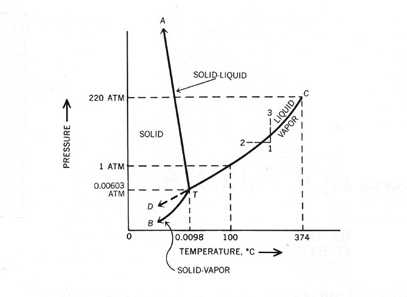

Triple point is the intersection on a phase diagram where three phases coexist in equilibrium. The most important application of triple point is water, where the three-phase equilibrium point consists of ice, liquid, and vapor. Before discussing triple point further, a basic understanding of the lines from Figure 1, the phase diagram of water, are first considered.
Take the line TC which gives the vapor pressure of liquid water up to the critical point C. Along this line, liquid and vapor coexist in equilibrium. At temperatures higher than that of point C, condensation does not occur at any pressure.
The line TA represents the vapor pressure of solid ice, which is a plot of the temperatures and pressures at which the solid and vapor are in equilibrium. Finally, line TB gives the melting point of ice and liquid water. The plot shows the temperatures and pressures at which ice and liquid water are in equilibrium.
(Note: At the dashed line TD, liquid water can be cooled below the freezing point to give supercooled water.)
The preceding paragraphs show that two phases are in equilibrium along the three solid lines. But when these lines intersect at one point C, three phases coexist in equilibrium. This intersection is the triple point, where a substance may simultaneously melt, evaporate, and sublime.

The figure shows that as the pressure increases, the melting point increases to a maximum at the triple point. We know the temperature at this point to be zero Celsius, which is the melting point of water.
Describe the changes that occur as a result of moving across the line from point 1 to point 2. and from point 1 to point 3.
In order to get to point 2, the temperature must decrease, while the pressure must increase to reach point 3. However, both process crosses the liquid-vapor equilibrium line in the direction of condensation from vapor to liquid.

Consider the pressure-temperature phase diagram for water of Figure 2. Apply the Gibbs Phase Rule to specify the number of degrees of freedom at the triple point C.
This problem calls for the Gibbs Phase Rule, which is
Applying this point to the triple point, the number of phases present P is 3, which makes F = 0.
Now consider the points A and B, find the degrees of freedom, then compare it to point C.
The phase rule F = 3 - P remains the same since it is the same system. At point A, only a single phase is present, so P=1. The number of degrees of freedom, F=2. At point B, which is the boundary between liquid and vapor phases, two phases are in equilibrium, making F = 1.
From these results we can conclude that at the triple point, where F = 0, we have no choice in the selection of externally controllable variables in order to define the system.
http://www.eng.vt.edu/eng/materials/classes/MSE2094_NoteBook/
96ClassProj/examples/triplpt.html